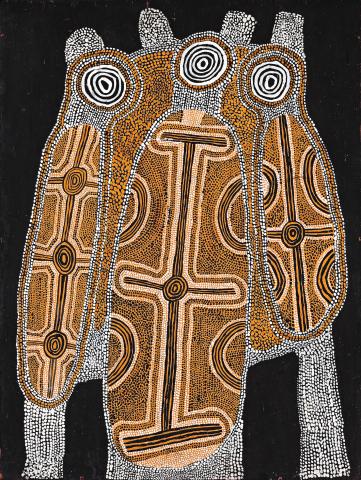WOMEN’S DREAMING, 1972
UTA UTA TJANGALA
synthetic polymer powder paint on composition board
60.5 x 45.5 cm
Painted at Papunya in April-May 1972
Geoffrey Bardon Collection, New South Wales
George Lindstrom, New South Wales, gifted by Geoffrey Bardon as a gesture of gratitude for the photography of paintings included in Bardon's first book on the Western Desert Art movement
Sotheby’s, Sydney, 28 July 2003, Lot 108
Private collection, New South Wales
Tjukurrtjanu: Origins of Western Desert Art, The Ian Potter Centre, National Gallery of Victoria, Melbourne, 30 September 2011 – 12 February 2012; Musée du Quai Branly, Paris, 9 October 2012 – 27 January 2013
Bardon, G., and Bardon, J., Papunya: A Place Made After the Story – The Beginnings of the Western Desert Painting Movement, The Miegunyah Press, Melbourne, 2004, painting 325, p. 373 (illus.)
Ryan, J., and Batty, P., Tjukurrtjanu: Origins of Western Desert Art, National Gallery of Victoria, Melbourne, 2011, p. 147 (illus.)
Bardon notes that ‘this is an old peoples story, where two women are indicated by the four dotted shapes at the top of the design representing two pairs of feet. Below them are three concentric circles representing waterholes, the left oval a ceremonial object showing body paint on a woman and the concave short lines representing the arms of the women. The other decoration on the ovals is also body paint and two of the large bottom shapes are arrangements of ceremonial sticks or legs of the ceremonial women.’
Bardon, G., and Bardon, J., 2004, p. 373
Uta Uta Tjangala was a man of charismatic self-confidence whose undisputed ceremonial authority enabled him to push through the constraints governing Western Desert painting.1 While other Pintupi artists sought inscrutability in abstraction, Uta Uta’s paintings are palpably visceral and profoundly personal. His urge for flamboyant self expression distinguishes his work from that of his peers, even as the technical means of their production seems virtually identical.
Uta Uta can be compared with Pablo Picasso, who, when collaborating with Georges Braque on the shared project of analytical cubism, inexorably gravitated toward figuration. Despite their mutual commitment to ‘impersonal authorship’ Picasso’s reductive planes and modeled forms always suggest the body. Every mark Picasso made spoke of his irrepressible sense of self.2
Like Picasso, Uta Uta is a painter of the body and his expansive gestures emanate from the centrality of ceremonial performance to his identity.3 The driving urgency of Women’s Dreaming, 1972 originates from the strength of Uta Uta’s identification with the epic travels of the Kungka Kutjarra (Two Women of the Dreaming). The site envisioned is most likely to be Ngurrapalangu, the place where Uta Uta’s mother first felt her son quicken within her. In the distant past, the Kungka Kutjarra danced at Ngurrapalangu, their feet creating the claypan that marks the site. The Kungka Kutajarra later fled north to Wilkinkarra (Lake Mackay), for they feared the advances of Yina, a lascivious old man. Disappointed yet again, Yina trudged westward towards his eventual sexual obliteration at Yumari, the site celebrated in some of Uta Uta’s most renowned canvases.4
Women’s Dreaming, 1972 is a fine example of Uta Uta’s work. Like the exertions of dancers within the constrictions of a small stage, the central sacred oval lunges forwards to the viewer while the discs at either side press at the edges of the board. The tumescent forms refuse to be constrained by the governing rectangular format on which it is painted. Intriguingly, for an art form based on the bird’s-eye view, Women’s Dreaming demands to be seen in elevation with the three large ovals advancing, like decorated performers, stamping towards the chorus on a ceremonial ground.
1. Myers, F., ‘Intrigue of the archive, enigma of the object’, Tjukurrtjanu: Origins of Western Desert Art, National Gallery of Victoria, Melbourne, 2011, pp. 31–32
2. Rubin, W., Picasso and Braque: Pioneering Cubism, Museum of Modern Art, New York, 1989, pp. 19–23
3. Myers, ibid.
4. Myers, F., Painting Culture: The Making of an Aboriginal High Art, Duke University Press, Durham, 2002, pp. 106–107
JOHN KEAN
